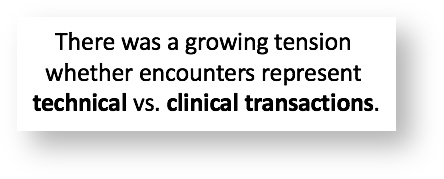...
Somewhere around 2008, we had a conversation at an OpenMRS Implementers Meeting about the need for a more flexible model to allow for more than paper form to be collected when the patient came to clinic. We also new knew that the existing one-encounter-per-paper-form approach was going to fall short as people started using OpenMRS to record hospitalizations. At that meeting, we came up with a more flexible design:
| Mockup | ||||
|---|---|---|---|---|
|
- Encounter would represent the clinical transaction between the care system and patient (e.g., the provider seeing the patient, documentation of a telephone call, vitals and other data collected by a triage nurse, etc.). Basically, it wouldn't change much from the point-in-time "transaction" for which paper encounter forms were used.
- Visit would be added to represent the actual "visit" to the provider over a period of time (hours, days, weeks, or more). A visit could contain one or more encounters. This would correspond to a clinic visit, but could also easily represent a entire hospitalization or virtual visit (like a telephone visit).
- Episodes of Care would be used to link encounter encounters across visits that were related. For example, grouping all encounters relating to a specific diagnosis or to a treatment program.
...
Then came real time (ad hoc) data entry...
We felt pretty good about the model of encounters capturing the clinical transactions, visits grouping these encounters into clinic visits & hospitalizations, and the flexibility of episodes of care to organize encounters in ways other than visits. But as people started using OpenMRS more & more in real-time care, creating mobile tools for data collection, and wanting to leverage web services, we discovered a way in which our model wasn't quite complete. There was a growing tension between grouping data into whether encounters to represent technical transactions vs. clinical/administrative transactions. Our encounters were meant to collect data (observations, orders, diagnoses, notes, etc.) within clinically meaningful groupings, like the paper encounter form. With real time data entry tools, we saw a growing number of cases where these data were coming in piecemeal. For example, a provider would enter a few orders and observations on their phone and enter diagnoses and some additional orders for the same encounter later or through a different tool. When we group the collected data to make the developers happy (in the technical transactions as data arrive), the grouping didn't make clinical sense; when we enforce the clinical groupings of data into encounters, the developers sometimes end up struggling with forcing the technical transactions & workflows to match the clinical need.
...
- A mobile device contributes an order to the encounter, a desktop app contributes a note and diagnoses, and a transcription process add some more orders, diagnoses, and observations. All of the transactions can contribute to the same encounter. The encounter represents the clinical transaction, yet we still know which data were contributed from which technical transaction.
- A provider uses a tool to contribute data to the encounter while interviewing and examining the patient. The data are entered in chunks meeting the needs of the provider's workflow and the particular tool. Later on, all of those transactions can be viewed as a single clinical encounter without losing the information about the individual technical transactions.
Design Ideas
| Gliffy | ||||
|---|---|---|---|---|
|
The simplest approach would be to add a technical "Transaction" grouping to link encounter data that were delivered within the same technical transaction:
| Gliffy | ||
|---|---|---|
|
. Any data within an encounter could be grouped within one or more technical transactions, representing the manner in which the pieces of the encounter were contributed. Then Encounter resource would contain or be linked to any clinical/administrative metadata (time of encounter, providers involved in encounter, type of encounter, etc.) and the Transaction resource would contain any technical metadata (time data received, method of data delivery, etc.).
Notes
- Encounter must exist (or be created) for any Transaction – i.e., a Transaction must be linked to at least one encounter.
- We could consider allowing a Transaction to span Encounters, since a technical transaction could potentially add/alter data within more than one Encounter (e.g., a chart audit in which multiple charts are affected). This would avoid the need for additional Transaction grouping, but might make the model and API more confusing.
See Also
